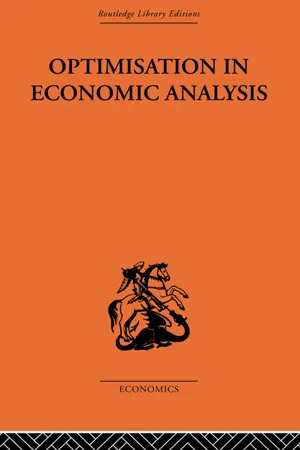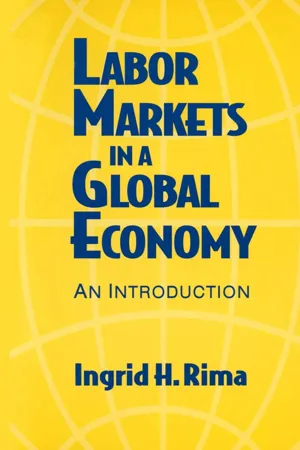Business
Total Product, Average Product, And Marginal Product
Total product refers to the total output produced by a firm. Average product is the total output per unit of input, while marginal product is the change in output resulting from a one-unit change in input. These concepts are important in understanding production efficiency and the relationship between inputs and outputs in a business.
Written by Perlego with AI-assistance
Related key terms
Related key terms
1 of 4
Related key terms
1 of 3
5 Key excerpts on "Total Product, Average Product, And Marginal Product"
- eBook - ePub
- Gary Becker(Author)
- 2017(Publication Date)
- Routledge(Publisher)
A production function defines a relationship between inputs and useful outputs. The word “useful” is included because the law of the conservation of matter guarantees that only the form, not the amount, of matter can be changed. A production function is sometimes said to give the maximal output obtainable from given inputs; not in the sense of a physical bound, but simply under given conditions or “state of the arts.” As conditions improve—as knowledge expands—the function “shifts” and a larger useful output is obtainable from the same inputs. Even at a moment in time, the functions vary from firm to firm, and, of course, from product to product as “entrepreneurial” knowledge and the nature of the product vary.A production function can be written asX = f(y 1,y 2, ... ,y m) ( 24-1 )where X is the amount of useful output, y 1 , y 2 , ..., y m the amounts of different factors, and f describes the relationship between the two. The marginal product of any factor is defined as the change in output caused by a unit change in that factor alone, or=M Pi=∂ X∂y i=∂ f(y 1, ... ,y m)∂ yif i ( 24-2 )The marginal productThe average product per unit of a particular factor is defined as the ratio of total output to the quantity of that factor,MPidepends on the amounts ofyiand other factors:yiand, say, y 2 are complements if an increase in y 2 raisesMPi; substitutes if it lowersMPi; and independent if it has no effect onMPi.Clearly this also depends on the amounts of different factors. The mathematical relation between marginal and average quantities derived in Lecture 3 and used again in Lecture 16 also applies here:AP i=X=y if(y 1, ... ,y m)y i ( 24-3 )MP i=A Pi( 1 +1)ϵA P ( 24-4 )where ϵ AP is the elasticity of factor i - eBook - ePub
- Gordon Mills(Author)
- 2014(Publication Date)
- Routledge(Publisher)
Chapter 3 , for a limited degree of variation around the initial input supplies.In this chapter, results are obtained for general cases in which a factor supply is varied over its entire feasible range. This section considers this question in the context of neoclassical analysis; the next section looks at the linear model. The analysis supposes that several inputs are used to make a single output. The question to be considered is: what happens when one input quantity is changed, while all other input quantities are held constant?Let y denote the total amount produced of the single output, and let x denote the amount of the input whose supply is varied. The marginal physical product or marginal product is defined as the rate of change of total product as the quantity of the specific input is changed; in calculus notation, the marginal product is dy/dx. The average product is, of course, y/x.Although the behaviour of average product and marginal product is an empirical matter, it is commonly found that marginal product declines as the input quantity increases. As a result, discussions of the neoclassical model in economics textbooks often take this as a premise, typically referring to it as the law of diminishing returns or the law of diminishing marginal productivity. Notwithstanding this terminology, it must be emphasised that the response is always an empirical question.One case of diminishing marginal productivity is reported in Marani and Fuchs (1964): in an irrigation experiment conducted in Israel, extra increments of water applied to plots of cotton gave smaller and smaller increments of cottonseed and lint; indeed, the largest water application actually gave lower yields than the second largest (i.e. marginal product turned negative).For a further example, consider the production function derived in section 5.2 for the instance of heat transfer. If the heat input x1 is held constant while the volume x2 of insulating material is increased, then the heat loss is reduced, and the heat output y - eBook - ePub
- Rob Dransfield(Author)
- 2013(Publication Date)
- Routledge(Publisher)
Comparing costs and revenues makes it possible to assess the profit that a business makes. The difference between the total revenue and the total cost of producing a given level of output is the profit.A marginal approach to profit maximization- Marginal costing looks at how additional output contributes to fixed costs and profits.
Review questionsRecommended Reading- Define the terms fixed cost, variable cost, contribution and break-even.
- How can break-even be calculated from contribution?
- Explain why the average cost curve has its characteristic U-shape.
- When and why do diminishing returns set in when more of a variable factor is added to a fixed factor?
- What happens to the following costs as output increases: (a) total cost; (b) average cost; and (c) marginal cost?
- What is the relationship between average and marginal revenue? Show how average and marginal revenue can be illustrated on the same graph.
- What is the relationship between marginal revenue and marginal cost? How can the profit maximizing point be identified by comparing marginal cost with marginal revenue?
- Draw a diagram to illustrate the profit maximizing point – by combining average cost, average revenue, marginal cost and marginal revenue on the same illustration.
- What business decisions can be informed by a process of marginal costing?
- How can a firm increase its profit from producing a given level of output?
Dransfield, R. (2004) Accounts Made Easy, Chapter 5, Cheltenham, Nelson Thornes.Useful Websites http://www.globusz.com/ebooks/costing/00000012.htm - eBook - ePub
Labor Markets in a Global Economy: A Macroeconomic Perspective
A Macroeconomic Perspective
- Ingrid H. Rima(Author)
- 2015(Publication Date)
- Routledge(Publisher)
It is also reflected in the slope of the production function q (N, K,), which is shown in the upper portion of Figure 10.1. This curve shows that total product increases at an increasing rate (i.e., marginal product increases) as long as additional variable inputs can be combined with increasing effectiveness with a given stock of fixed factors. But variable factors cannot be added without eventually encountering diminishing returns and rising average and marginal costs of production; if a firm changes its short-run output by varying the “mix” of its factor inputs, it experiences a U-shaped cost curve like that represented in Figure 3.2, panel A (p. 49). In the hypothetical example of Table 10.1, diminishing returns take place after five labor inputs are employed. Thereafter, labor’s marginal product falls, eventually becoming zero. If still more labor inputs are added, marginal product will eventually become negative. Total product, Q, increases only as long as the marginal product is positive, and is at a maximum when the marginal product of the variable factor is zero. In principle, the decision rule that guides a firm is quite simple. Given the selling price of its product, the firm evaluates a worker’s physical product in terms of its money value; that is, in terms of the market price of its output. Two magnitudes are important: marginal revenue product and average revenue product. The marginal revenue product of labor (MRP n) is its marginal physical product multiplied by the marginal revenue his output yields. The average revenue product of labor (ARP n) is the worker’s average physical product multiplied by the selling price of his output. The MRP n and the ARP n associated with various labor inputs can be represented graphically as in the lower portion of Figure 10.1. Average and marginal dollar receipts are measured on the vertical axes and the number of labor units hired are measured on the horizontal axis - eBook - ePub
- William G. Tomek, Harry M. Kaiser(Authors)
- 2014(Publication Date)
- Cornell University Press(Publisher)
Figure 4-1 . These curves are based not only on fixed input prices but also on the assumption of a given technology—a given production function—for a given (optimal) plant size. In other words, these variables are held constant in deriving a supply schedule. As previously suggested, the rates of change of the marginal and average costs functions are related to the form of the underlying production function (input-output relationship). The upward slope of the marginal cost curve assumes that diminishing returns occur as additional units of the input are used. For example, increasing the level of fertilizer increases yield, but probably at a diminishing rate, and ultimately yields can decline if “too much” fertilizer is used.It should be noted, as an aside, that the behavior of marginal costs can vary with the type of output under analysis. For example, if the output is the service of storing a commodity, marginal costs might plausibly be a fixed, constant amount over a considerable range of storage; as long as storage capacity exists, the addition of another unit of commodity to the inventory may not result in a larger marginal cost. Diminishing returns are probably not perceptible over a broad range of the storage function.For our purposes, however, the point to emphasize is that given the common assumption of rising marginal costs, the optimal output varies as the price of the product rises or falls (Figure 4-1 ). The price of A equals marginal revenue, assuming firms in a competitive industry (see Chapter 5), and the optimal output of the firm depends on the intersection of this price with marginal costs. If, for instance, the output amount is at a marginal cost that is less than marginal revenue, then an increase in output would result in an incremental increase in revenue that is larger than the incremental increase in cost.Figure 4-1. Cost curves and optimum output at alternative pricesThe average total and average variable cost curves are also important in understanding supply response. Variable costs are those that change with the quantity produced and can be avoided by ceasing production. Total costs combine variable and fixed costs (those costs that do not vary with output). Thus, the average total cost function lies above the average variable cost function (Figure 4-1
Index pages curate the most relevant extracts from our library of academic textbooks. They’ve been created using an in-house natural language model (NLM), each adding context and meaning to key research topics.
Explore more topic indexes
Explore more topic indexes
1 of 6
Explore more topic indexes
1 of 4




